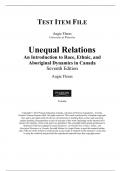Exam (elaborations)
Test Bank For Unequal Relations An Introduction to Race, Ethnic, and Aboriginal Dynamics in Canada, 7E Augie Flera
- Institution
- Unequal Relations An Introduction To
Test Bank For Unequal Relations An Introduction to Race, Ethnic, and Aboriginal Dynamics in Canada, 7E Augie Flera
[Show more]



